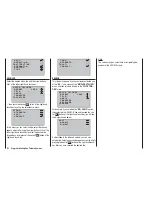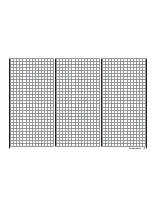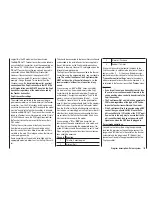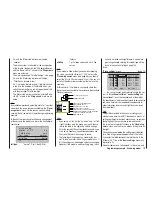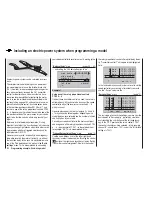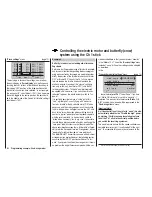
146
Programming example - fi xed-wing model
First steps in programming a new model
Example: non-powered fi xed-wing model aircraft
When
programming
a new model you should start by
activating the …
“select model”
sub-menu
(page 52)
… in the “
Model memory
” menu. Use the arrow buttons
cd
of the left or right-hand touch-key to select a free
model memory …
03
04
05
¿¿
free
¿¿
02
01
06
R08
¿¿
free
¿¿
¿¿
free
¿¿
¿¿
free
¿¿
¿¿
free
¿¿
… then touch the central
SET
button of the right-hand
touch-key. You are now immediately requested to select
the type of model you wish to program.
Sel model type
( empty mod mem )
Since in this example we are setting up a fi xed-wing
model, we simply confi rm the fi xed-wing model symbol
with a brief press on the central
SET
button of the right-
hand touch-key; the screen now reverts to the basic
display.
Notes:
Naturally you can also use the pre-defi ned model
•
memory 01 for programming your fi rst model; this is
the “fi xed-wing model” type by default.
Once you have called up the “Model select” option it
•
is not possible to interrupt the process, i. e. you must
choose one or other model type. Even if you switch
off the transmitter at this point, you cannot avoid this
select procedure. However, if you make a mistake
you can always correct it simply by erasing the mod-
el memory.
If the battery voltage is too low, you will not be able
•
to change model memories for safety reasons. The
screen then displays an appropriate message:
not possible now
voltage too low
Once you have overcome this initial hurdle, you may
need to bind the receiver installed in the model to this
model memory in the …
“Basic settings”
menu
(pages 56 … 62)
This is accomplished by moving to the “
rx bind
” line:
phase 3
phase 4
landing
speed –––
receiv out
rx bind
–––
phase 2
takeoff
–––
–––
Note:
When you confi rm the model selection the following
message appears in the basic display for a few seconds:
BIND N/A
OK
If you confi rm your choice by briefl y pressing the SET
button of the right-hand four-way button, you automati-
cally move to this line:
In this line you trigger the bind process between model
memory and receiver, as described in detail on pages
61. Without this step you cannot address the receiver.
The next step is to press the
c
arrow button of the
left-hand or right-hand four-way touch-key to move up
into the fi rst line, where you can start the actual model
programming in the “
mod name
” line:
mod name
stick mode
CH8 delay
motor at C1
1
yes
no
tail type
nor mal
At this point you can enter the “
Model name
” by touch-
ing the central
SET
button of the right-hand touch-key in
order to move to the character table:
0123456789
PQRSTUVWXYZ
model name
?
: ;
A
B
CDEFGHIJKLMNO
GRAU
B
You should also check the settings for “
Stick mode
” and
“
Motor at Ch 1
” and change them if necessary:
“none”:
•
The brake system is “retracted” at the
forward
posi-
tion of the throttle / brake stick; the “Ch8 delayed” op-
tion and the “Brake
¼
NN *” mixers in the “
Wing mi-
xers
” menu are
activated
.
The warning message “Throttle too high” - see page
* NN = Nomen Nominandum (name to be stated)
Summary of Contents for mx-16 HOTT
Page 7: ...7 For your notes...
Page 37: ...37 For your notes...
Page 41: ...41 For your notes...
Page 45: ...45 For your notes...
Page 51: ...51 For your notes...
Page 55: ...55 For your notes...
Page 81: ...81 For your notes...
Page 103: ...103 For your notes...
Page 133: ...133 For your notes...
Page 141: ...141 For your notes...
Page 161: ...161 For your notes...
Page 173: ...173 For your notes...

